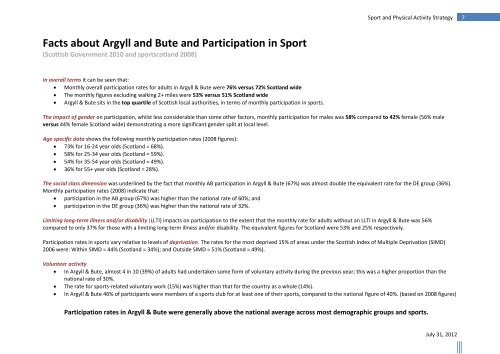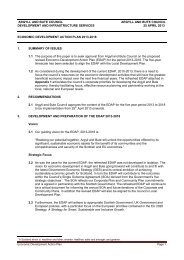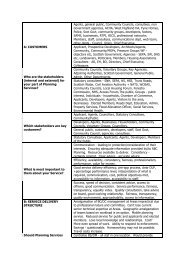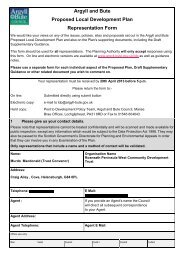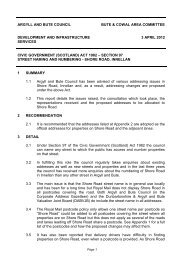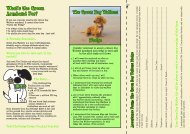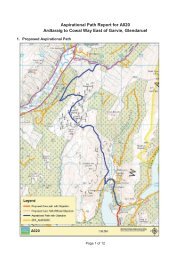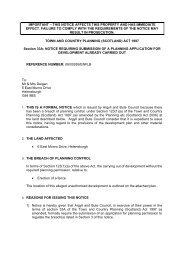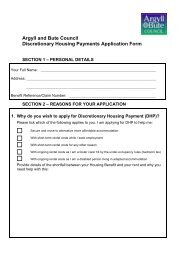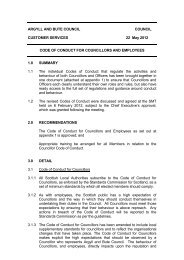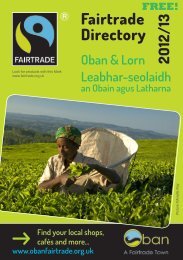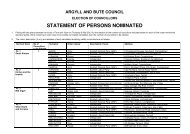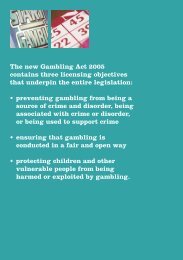Sport and Physical Activity Strategy - Argyll and Bute Council
Sport and Physical Activity Strategy - Argyll and Bute Council
Sport and Physical Activity Strategy - Argyll and Bute Council
You also want an ePaper? Increase the reach of your titles
YUMPU automatically turns print PDFs into web optimized ePapers that Google loves.
<strong>Sport</strong> <strong>and</strong> <strong>Physical</strong> <strong>Activity</strong> <strong>Strategy</strong>7Facts about <strong>Argyll</strong> <strong>and</strong> <strong>Bute</strong> <strong>and</strong> Participation in <strong>Sport</strong>(Scottish Government 2010 <strong>and</strong> sportscotl<strong>and</strong> 2008)In overall terms it can be seen that: Monthly overall participation rates for adults in <strong>Argyll</strong> & <strong>Bute</strong> were 76% versus 72% Scotl<strong>and</strong> wide The monthly figures excluding walking 2+ miles were 53% versus 51% Scotl<strong>and</strong> wide <strong>Argyll</strong> & <strong>Bute</strong> sits in the top quartile of Scottish local authorities, in terms of monthly participation in sports.The impact of gender on participation, whilst less considerable than some other factors, monthly participation for males was 58% compared to 42% female (56% maleversus 44% female Scotl<strong>and</strong> wide) demonstrating a more significant gender split at local level.Age specific data shows the following monthly participation rates (2008 figures): 73% for 16-24 year olds (Scotl<strong>and</strong> = 68%). 58% for 25-34 year olds (Scotl<strong>and</strong> = 59%). 54% for 35-54 year olds (Scotl<strong>and</strong> = 49%). 36% for 55+ year olds (Scotl<strong>and</strong> = 28%).The social class dimension was underlined by the fact that monthly AB participation in <strong>Argyll</strong> & <strong>Bute</strong> (67%) was almost double the equivalent rate for the DE group (36%).Monthly participation rates (2008) indicate that: participation in the AB group (67%) was higher than the national rate of 60%; <strong>and</strong> participation in the DE group (36%) was higher than the national rate of 32%.Limiting long-term illness <strong>and</strong>/or disability (LLTI) impacts on participation to the extent that the monthly rate for adults without an LLTI in <strong>Argyll</strong> & <strong>Bute</strong> was 56%compared to only 37% for those with a limiting long-term illness <strong>and</strong>/or disability. The equivalent figures for Scotl<strong>and</strong> were 53% <strong>and</strong> 25% respectively.Participation rates in sports vary relative to levels of deprivation. The rates for the most deprived 15% of areas under the Scottish Index of Multiple Deprivation (SIMD)2006 were: Within SIMD = 44% (Scotl<strong>and</strong> = 34%); <strong>and</strong> Outside SIMD = 51% (Scotl<strong>and</strong> = 49%).Volunteer activity In <strong>Argyll</strong> & <strong>Bute</strong>, almost 4 in 10 (39%) of adults had undertaken some form of voluntary activity during the previous year; this was a higher proportion than thenational rate of 30%. The rate for sports-related voluntary work (15%) was higher than that for the country as a whole (14%). In <strong>Argyll</strong> & <strong>Bute</strong> 46% of participants were members of a sports club for at least one of their sports, compared to the national figure of 40%. (based on 2008 figures)Participation rates in <strong>Argyll</strong> & <strong>Bute</strong> were generally above the national average across most demographic groups <strong>and</strong> sports.July 31, 2012


